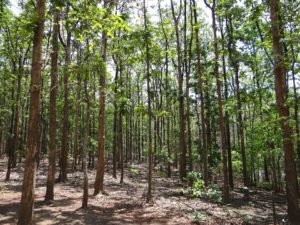Have you noticed different kinds of plants and vegetation when you travel to different states? Even around your house, you can notice various types of trees and bushes! Such is the diverse natural vegetation of India. In this chapter, we will cover some basics about the natural vegetation of India. We will also look at some interesting classifications and examples of the same.
Suggested Videos
What is Natural Vegetation?
Natural vegetation refers to a plant community which has grown naturally without human aid. They have been left undisturbed by humans for a long time. We call this virgin vegetation. Thus, cultivated crops and fruits, orchards form part of vegetation but not natural vegetation. Now, we will look at some of the factors that impact the vegetation in our country.
Browse more Topics under Natural Vegetation And Wildlife
Learn more about Natural Vegetation and Wildlife in detail here.
The Climate of the Region
Temperature and humidity determine the character and extent of vegetation. The precipitation and soil also play a major role in determining the degree of vegetation. Therefore, various places in India have various vegetation patterns.
Photoperiod also affects the vegetation of a place. It is the variation in duration of sunlight at different places due to differences in latitude, altitude, season and duration of the day. Hence, depending on the photoperiod, you get different kinds of vegetation at different places. Now, we will look at the various types of vegetation.

Types of vegetation
We have the following major types of vegetation in our country:
Tropical Rain Forests
These forests are restricted to heavy rainfall areas of the Western Ghats and the island groups of Lakshadweep, Andaman and Nicobar, upper parts of Assam and Tamil Nadu coast. They are at their best in areas having more than 200 cm of rainfall with a short dry season. The trees reach great heights up to 60 meters or even above. Some of the commercially important trees of this forest are ebony, mahogany, rosewood, rubber and cinchona.
Tropical Deciduous Forests
These are the most widespread forests of India. They are the monsoon forests and spread over the region receiving rainfall between 200 cm and 70 cm. Trees of this forest-type shed their leaves for about six to eight weeks in dry summer.
Read about Indian Climate and Vegetation here in detail.
These forests exist, therefore, mostly in the eastern part of the country – northeastern states, along with the foothills of the Himalayas, Jharkhand, West Orissa and Chhattisgarh, and on the eastern slopes of the Western Ghats. Teak is the most dominant species of this forest. Bamboos, sal, shisham, sandalwood, khair, Kusum, Arjun, mulberry are other commercially important species.
The Thorn Forests and Scrubs
In regions with less than 70 cm of rainfall, the natural vegetation of India consists of thorny trees and bushes. This type of vegetation is found in the north-western part of the country including semi-arid areas of Gujarat, Rajasthan, Madhya Pradesh, Chhattisgarh, Uttar Pradesh and Haryana. Acacias, palms, euphorbias and cacti are the main plant species. Trees are scattered and have long roots penetrating deep into the soil in order to get moisture.
Montane Forests
In mountainous areas, the decrease in temperature with increasing altitude leads to the corresponding change in natural vegetation of India. You can find the wet temperate type of forests between a height of 1000 and 2000 metres. Evergreen broad-leaf trees such as oaks and chestnuts predominate. Between 1500 and 3000 meters, you can find the temperate forests containing coniferous trees like pine, deodar, silver fir, spruce, and cedar.
Mangrove Forests
You can find the mangrove tidal forests in the areas of coasts influenced by tides. Mud and silt get accumulated on such coasts. Dense mangroves are the common varieties with roots of the plants submerged under water. You can find these in the deltas of the Ganga, the Mahanadi, the Krishna, the Godavari and the Kaveri.
Medicinal Plants in India
India is famous for its herbs and spices from ancient times. The World Conservation Union’s Red list has named 352 medicinal plants of which 52 are critically threatened and 49 endangered. The commonly used plants in India are:
- Sarpagandha: We can use it to treat blood pressure. It is found only in India.
- Jamun: The juice from ripe fruit helps to prepare vinegar which is carminative and diuretic, and has digestive properties. The powder of the seed helps in controlling diabetes.
- Arjun: The fresh juice of leaves is a cure for an earache. It also regulates blood pressure.
- Babool: People use the leaves to cure eyesores. Its gum is used as a tonic.
- Neem: It has high antibiotic and antibacterial properties.
- Tulsi Plant: It helps to cure a cough and cold.
- Kachnar: This plant helps to cure asthma and ulcers. The buds and roots are good for digestive problems.
Question For You
Q. Write a note on the montane forests in India.
Ans: In mountainous areas, the decrease in temperature with increasing altitude leads to the corresponding change in natural vegetation. You can find the wet temperate type of forests between a height of 1000 and 2000 meters. Evergreen broad-leaf trees such as oaks and chestnuts predominate. Between 1500 and 3000 meters, you can find the temperate forests containing coniferous trees like pine, deodar, silver fir, spruce, and cedar.






Why the revolt of 1857 is important